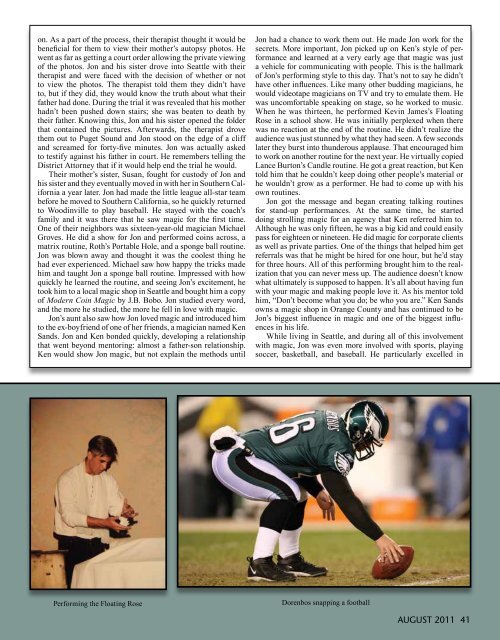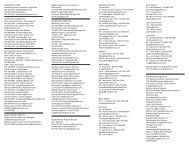(Hank) Moorehouse 1934 – 2011 - The Society of American Magicians
(Hank) Moorehouse 1934 – 2011 - The Society of American Magicians
(Hank) Moorehouse 1934 – 2011 - The Society of American Magicians
You also want an ePaper? Increase the reach of your titles
YUMPU automatically turns print PDFs into web optimized ePapers that Google loves.
on. As a part <strong>of</strong> the process, their therapist thought it would be<br />
beneficial for them to view their mother’s autopsy photos. He<br />
went as far as getting a court order allowing the private viewing<br />
<strong>of</strong> the photos. Jon and his sister drove into Seattle with their<br />
therapist and were faced with the decision <strong>of</strong> whether or not<br />
to view the photos. <strong>The</strong> therapist told them they didn’t have<br />
to, but if they did, they would know the truth about what their<br />
father had done. During the trial it was revealed that his mother<br />
hadn’t been pushed down stairs; she was beaten to death by<br />
their father. Knowing this, Jon and his sister opened the folder<br />
that contained the pictures. Afterwards, the therapist drove<br />
them out to Puget Sound and Jon stood on the edge <strong>of</strong> a cliff<br />
and screamed for forty-five minutes. Jon was actually asked<br />
to testify against his father in court. He remembers telling the<br />
District Attorney that if it would help end the trial he would.<br />
<strong>The</strong>ir mother’s sister, Susan, fought for custody <strong>of</strong> Jon and<br />
his sister and they eventually moved in with her in Southern California<br />
a year later. Jon had made the little league all-star team<br />
before he moved to Southern California, so he quickly returned<br />
to Woodinville to play baseball. He stayed with the coach’s<br />
family and it was there that he saw magic for the first time.<br />
One <strong>of</strong> their neighbors was sixteen-year-old magician Michael<br />
Groves. He did a show for Jon and performed coins across, a<br />
matrix routine, Roth’s Portable Hole, and a sponge ball routine.<br />
Jon was blown away and thought it was the coolest thing he<br />
had ever experienced. Michael saw how happy the tricks made<br />
him and taught Jon a sponge ball routine. Impressed with how<br />
quickly he learned the routine, and seeing Jon’s excitement, he<br />
took him to a local magic shop in Seattle and bought him a copy<br />
<strong>of</strong> Modern Coin Magic by J.B. Bobo. Jon studied every word,<br />
and the more he studied, the more he fell in love with magic.<br />
Jon’s aunt also saw how Jon loved magic and introduced him<br />
to the ex-boyfriend <strong>of</strong> one <strong>of</strong> her friends, a magician named Ken<br />
Sands. Jon and Ken bonded quickly, developing a relationship<br />
that went beyond mentoring: almost a father-son relationship.<br />
Ken would show Jon magic, but not explain the methods until<br />
Performing the Floating Rose<br />
Jon had a chance to work them out. He made Jon work for the<br />
secrets. More important, Jon picked up on Ken’s style <strong>of</strong> performance<br />
and learned at a very early age that magic was just<br />
a vehicle for communicating with people. This is the hallmark<br />
<strong>of</strong> Jon’s performing style to this day. That’s not to say he didn’t<br />
have other influences. Like many other budding magicians, he<br />
would videotape magicians on TV and try to emulate them. He<br />
was uncomfortable speaking on stage, so he worked to music.<br />
When he was thirteen, he performed Kevin James’s Floating<br />
Rose in a school show. He was initially perplexed when there<br />
was no reaction at the end <strong>of</strong> the routine. He didn’t realize the<br />
audience was just stunned by what they had seen. A few seconds<br />
later they burst into thunderous applause. That encouraged him<br />
to work on another routine for the next year. He virtually copied<br />
Lance Burton’s Candle routine. He got a great reaction, but Ken<br />
told him that he couldn’t keep doing other people’s material or<br />
he wouldn’t grow as a performer. He had to come up with his<br />
own routines.<br />
Jon got the message and began creating talking routines<br />
for stand-up performances. At the same time, he started<br />
doing strolling magic for an agency that Ken referred him to.<br />
Although he was only fifteen, he was a big kid and could easily<br />
pass for eighteen or nineteen. He did magic for corporate clients<br />
as well as private parties. One <strong>of</strong> the things that helped him get<br />
referrals was that he might be hired for one hour, but he’d stay<br />
for three hours. All <strong>of</strong> this performing brought him to the realization<br />
that you can never mess up. <strong>The</strong> audience doesn’t know<br />
what ultimately is supposed to happen. It’s all about having fun<br />
with your magic and making people love it. As his mentor told<br />
him, “Don’t become what you do; be who you are.” Ken Sands<br />
owns a magic shop in Orange County and has continued to be<br />
Jon’s biggest influence in magic and one <strong>of</strong> the biggest influences<br />
in his life.<br />
While living in Seattle, and during all <strong>of</strong> this involvement<br />
with magic, Jon was even more involved with sports, playing<br />
soccer, basketball, and baseball. He particularly excelled in<br />
Dorenbos snapping a football<br />
AUGUST <strong>2011</strong> 41



